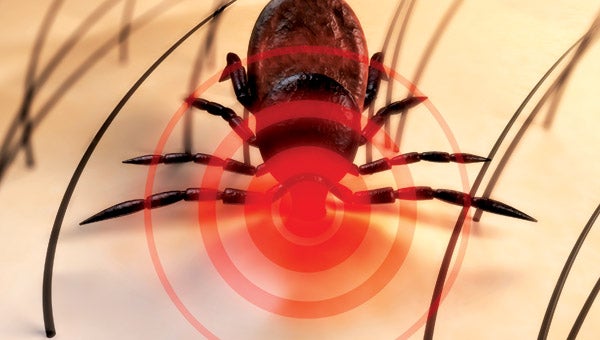The great imitator
Published 10:04 pm Saturday, May 7, 2011
Lyme Disease is a complex illness that’s difficult to diagnose
When her son got a tick bite while at a friend’s house in 2009, Suffolk resident Candy Fisk didn’t think much of it.
Candy would find out nearly a year later that Jeff, her son, was infected with Lyme disease.
Lyme disease is an inflammatory disease caused by bacteria spread through tick bites. Ticks pick up the bacteria when they bite mice or deer that are infected, and then spread it when they bite humans.
Jeff still battles severe symptoms that appear regularly as a result of Lyme disease, as well as several other infections associated with it.
He has muscle aches, joint pain, migraine headaches, memory loss and blindness in one eye. But Candy said the worse symptom is panic attacks.
“In the middle of the night, he wakes up in tears,” she said. “He thinks he’s dying, and he’ll call me, and I have to calm him down.”
Candy said she had no idea how dangerous one little tick could be before Jeff was infected.
When Jeff started having body aches and running a fever after the bite, Candy said they thought it was unrelated.
“It started out with just a bite,” she said. “Then he got sick, and we thought it was just the flu.”
Joy Walker, director of the Hampton Roads chapter of the National Capital Lyme and Tick-Borne Disease Association, has had symptoms from Lyme for 16 years. She said one of the tricky things about Lyme is that it can mimic the symptoms of other diseases.
“It’s known as the ‘great imitator’ because it can look like 300 different diseases,” she said.
As a result, many people, like Jeff, don’t look into the symptoms, she said.
However, Jeff decided to go a local doctor and get checked for Lyme when a distinct bull’s-eye rash, which is sometimes associated with the disease, appeared at the bite location.
After a blood test came up negative, the doctor gave him antibiotics to treat the rash.
But the existing symptoms persisted and new ones appeared, like blurred vision and dizziness.
He visited two more doctors in the area, who suspected everything from multiple sclerosis to fibromyalgia. But even after an MRI, no one could diagnose Jeff.
“The whole time he was getting sicker and sicker,” Candy said. “It took a long time to get a formal diagnosis.”
Walker said there are a lot of misconceptions and disagreements among doctors about Lyme disease that leads to misdiagnosis.
Lyme symptoms can show up suddenly or after many months, she said, and the symptoms can vanish in weeks or persist for years.
Mainstream medicine, she said, believes two to four weeks of antibiotics will cure Lyme, but some doctors believe it is an incurable disease.
As a result, Walker said other medical professionals look down doctors who treat it as a chronic condition.
“There does seem to be a little discrimination against doctors who treat chronic Lyme,” she said. “You have very few doctors, and you have to travel to see them.”
That is exactly what Jeff had to do. Last October, she traveled with him to Maryland to see a specialist who diagnosed Lyme and started treating it along with his co-infections.
Jeff travels every month to see his specialist on his own dollar because he does not have insurance.
Candy said the expense is terrible but worth it, because Jeff is now on medication that keep his symptoms at bay and has improved his condition.
But his doctor isn’t sure if he will ever get his sight back.
“It’s been eating away at everything for so long, it’s going to be a long time to get it under control,” Candy said.
She said everybody should read up on Lyme disease, especially this time of year when numerous ticks are out.
If you get a tick bite, don’t ignore any symptoms, she said.
“Don’t ignore anything weird that happens,” she said. “Anytime you get a tick bite, don’t ignore it.”
Because of their experience with the disease, Candy and Jeff are part of the Hampton Roads Lyme association Walker directs.
For Lyme disease awareness month this month, the chapter will host a Walk to Defeat Lyme Disease May 21 at Mount Trashmore in Virginia Beach. Registration for the 1.5-mile walk starts at 8:30 a.m.
“We’re looking to have a sea of lime green shirts to show that Lyme is in this area,” Walker said.
For more information on the disease and walk, visit natcaplyme.org.



